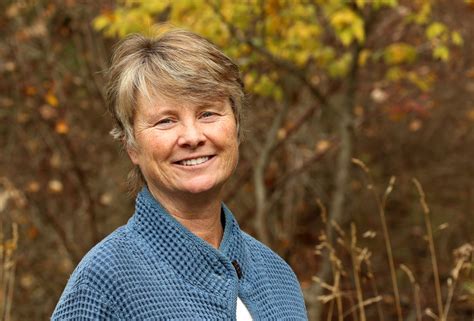Top 44 Quotes & Sayings by Janine Benyus
Explore popular quotes and sayings by an American writer Janine Benyus.
Last updated on April 14, 2025.
A solitary American monk named Thomas Berry writes that in our relationship to nature, we have been autistic for centuries. Wrapped tightly in our own version of knowledge, we have been unreceptive to the wisdom of the natural world. To tune in again, to have the "spontaneous environmental rapport" that characterized our ancestors, will take doing something that is perfectly delightful: reimmersing ourselves in the natural world.
After decades of faithful study, ecologists have begun to fathom hidden likenesses among many interwoven systems. ...a canon of nature's laws, strategies, and principles...
Nature runs on sunlight.
Nature uses only the energy it needs.
Nature fits form to function.
Nature recycles everything.
Nature rewards cooperation.
Nature banks on diversity.
Nature demands local expertise.
Nature curbs excesses from within.
Nature taps the power of limits.
Biomimicry is innovation inspired by nature. In a society accustomed to dominating or 'improving' nature, this respectful imitation is a radically new approach, a revolution really. Unlike the Industrial Revolution, the Biomimicry Revolution introduces an era based not on what we can extract from nature, but on what we can learn from her.
If the age of the Earth were a calendar year and today were a breath before midnight on New Year's Eve, we showed up a scant fifteen minutes ago, and all of recorded history has blinked by in the last sixty seconds. Luckily for us, our planet-mates--the fantastic meshwork of plants, animals, and microbes--have been patiently perfecting their wares since March, an incredible 3.8 billion years since the first bacteria. ...After 3.8 billion years of research and development, failures are fossils, and what surrounds us is the secret to survival.
For the 99 percent of the time we've been on Earth, we were hunter and gatherers, our lives dependent on knowing the fine, small details of our world. Deep inside, we still have a longing to be reconnected with the nature that shaped our imagination, our language, our song and dance, our sense of the divine.
Jay Harman is the quintessential biomimic, a principled inventor who sees solutions everywhere he looks in the natural world. And he looks deeply, with the soul of a student. He moves with grace from a world of waving sea kelp to the world of sustainable design, bringing nature's wisdom into the board rooms of global companies, to the design tables of the engineers and designers who make our world. This is more than a business book, more than a memoir, more than a new way to solve global challenges. It's a book about a new way to think.
For a long time we have thought we were better than the living world, and now some of us tend to think we are worse, that everything we touch turns to soot. But neither perspective is healthy. We have to remember how it feels to have equal standing in the world, to be "between the mountain and the ant . . . part and parcel of creations," as the Iroquois traditionalist Oren Lyons says.






















